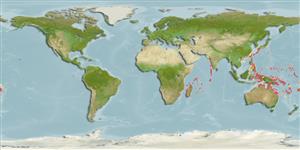Classification / Names
Common names from other countries
Main reference
Size / Weight / Age
Max length : 3.8 cm SL male/unsexed; (Ref. 75031)
Environment
Marine; reef-associated; depth range 0 - 10 m (Ref. 6211)
Climate / Range
Tropical, preferred ?
Distribution
Short description
Dorsal
spines
(total): 16 - 18;
Dorsal
soft rays
(total): 10-12;
Anal
spines: 1;
Anal
soft rays: 19 - 21;
Vertebrae: 36 - 38. Diagnosis: Dorsal fin III + XIV+ 11, 1st fin 4/5 height of 2nd fin, 1 free pterygiophore between 2nd and 3rd fin; anal fin I + 21; pectoral rays 17 (1+9+7); pelvic fin I, 2, spine short and hidden, segmented rays simple, partially united by membrane. Vertebrae 10 + 27. LL total lateral scales 39-40; tubed 22-30 scales, ends below anterior half of 3rd dorsal fin; nape, 1st and 2nd dorsal fin and anal-fin base scaleless, caudal fin base with 1 row of scales. Mandibular pores 5-8+1-2+5-8. Orbital cirrus simple. Head length 3.4 in SL; eye 2.9, maxilla 2.1 in HL. Male head with blue stripe below eye from mouth to pectoral-fin base and masked with black on ventral half; body pinkish orange with scattered dusky rosettes denser ventrally; larger ones with 5-6 light grey blotches and dusky triangular marks; median fins generally uniformly dark to black. Female paler version of male but not masked (Ref. 75031).
IUCN Red List Status (Ref. 115185)
Threat to humans
Harmless
Human uses
More information
ReferencesAquacultureAquaculture profileStrainsGeneticsAllele frequenciesHeritabilityDiseasesProcessingMass conversion
Tools
Special reports
Download XML
Internet sources
Estimates of some properties based on models
Phylogenetic diversity index
PD50 = 0.5000 many relatives (e.g. carps) 0.5 - 2.0 few relatives (e.g. lungfishes)
Trophic Level
3.1 ±0.3 se; Based on size and trophs of closest relatives
Resilience
High, minimum population doubling time less than 15 months (Preliminary K or Fecundity.)
Vulnerability
Low vulnerability (10 of 100)
Price category
